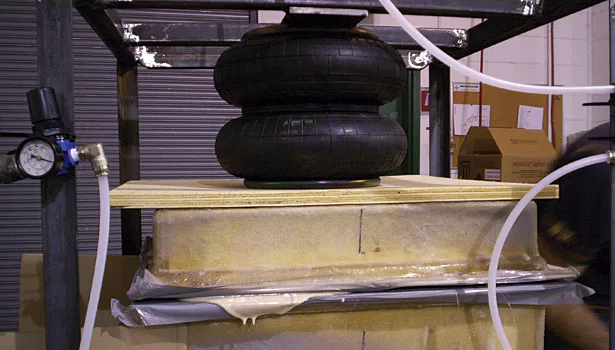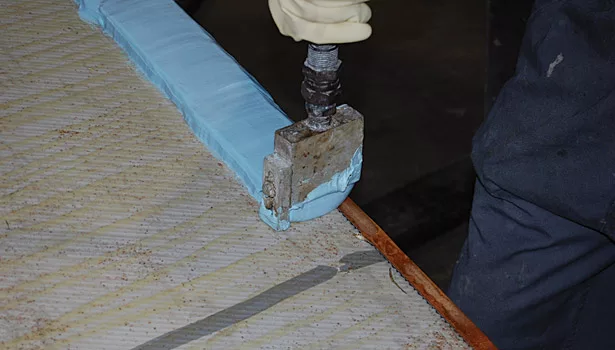Composite Assembly Solutions


For as long as polyester chemistry has been used to produce composite parts, manufacturers have needed various paste consistency resin products to work in conjunction with the laminating process. These paste materials are often used for wet-on-wet and post-assembly requirements. Paste materials take advantage of similar chemistries to co-cure and have been tailored for consistency, cure rate, hardness, and a host of features focused on meeting specific performance needs.
VERSATILITY
Polyester-based bonding compounds offer unique advantages in certain requirements. While other chemistries may not be adjustable, polyester-based bonding
Polyester-based bonding compounds offer unique advantages in certain requirements. |
compounds use the same chemistry as the composites being fabricated, so the cure speed may be tailored around local temperatures. In most cases, putties can be adjusted for gel time and exotherm by manipulating the initiator (often called the catalyst) level and initiator type. In extreme cases, where ambient temperatures run as low 65°F or as high as more than 100°F, putty fabricators can offer seasonally adjusted versions of the same product.
Polyester chemistry is versatile and offers a broad range of base resins, including orthopthalic, isopthalic, dicyclopentadiene and vinyl esters. Each variety of resin offers unique performance characteristics. Putty formulas are not only tailored around cure speed, but also around flexibility, tensile, moisture resistance, shrinkage, color, sanding and other features. Many companies that offer resins also have an in-depth selection of putty products to solve fabrication needs.
PROCESSING
Polyester putties and adhesive materials are easy to process. Keep in mind that there is an advantage to the operators being familiar with the chemistry. Less training is required when an operator is comfortable with compatible lamination products; the same initiators are often used for both laminating and putty application. Equipment used for bulk requirements has the same advantage; the same style of equipment and supplier may be used to support both applications, thereby easing maintenance and equipment training.
In addition, product support for putty products is generally excellent, and these products are largely manufactured by the same companies that offer composite resins. Local representatives who are already visiting customers can provide a great deal of product depth and experience to composite assembly requirements.
Specific processes such as core installation, hull and deck assembly, and component bonding have a long history of time-proven success. Within the industry, a number of well-known articles, publications, application guides and manuals have been produced by various suppliers. The depth of information regarding materials—and, accordingly, the processes to apply these materials—is impressive. When discussing application requirements with vendors, be sure to ask if they have application support information for your requirements.
ON THE MARKET
The economy of polyester bonding is easy to understand. Polyester pricing is well-known within the composites industry. As a result of its chemical nature, polyester bonding often offers a cost advantage over nearly any other product available.
Innovative processes have led to an updated array of products to stay in step with fabrication technologies.
- Some of today’s putty products can co-cure within closed tooling processes.
- Double-sided tooling requires a putty to gap fill and bond, such as with in-mold displacement (IMD).
- Bonding putties are available for spray as well as extrudable applications.
- Vehicle fabrication requires bonding putties with low shrink and print to suit demanding surface finish.
- Other new products include bonding and filling putties that are fire retardant, smoke suppressive and low in toxicity.
Applications for bonding putties have expanded exponentially to cover ever-changing requirements. Today, specialty putty products have expanded roles beyond bonding, filling and fairing. Specialty products are used for combination requirements, such as radius filling and print blockage, and some polyester putty products can edge-fill and reinforce honeycomb cores. In addition, putty products are now available as routable material to fabricate master patterns for tooling.
Polyester bonding materials are not a panacea, but they do deserve a first look. The versatile chemistry offers easy processing, product support, range of materials and obvious economy. Industry demands that manufacturers consider the best options for bonding requirements, and this assembly solution should remain at the forefront for fiberglass fabrication.
For more information, contact the author at (819) 477-1180 or murray.akerman@ccpcomposites.ca.
Looking for a reprint of this article?
From high-res PDFs to custom plaques, order your copy today!





